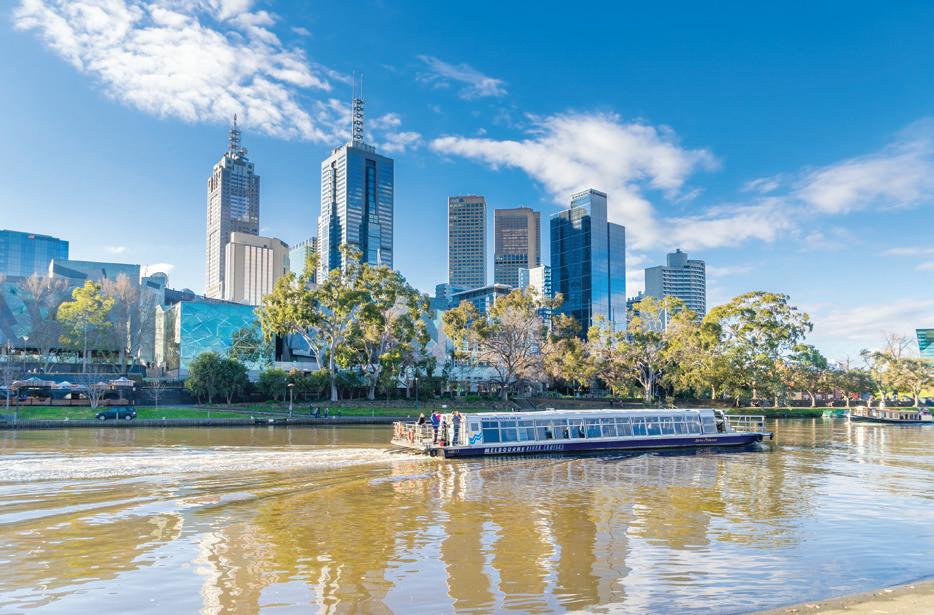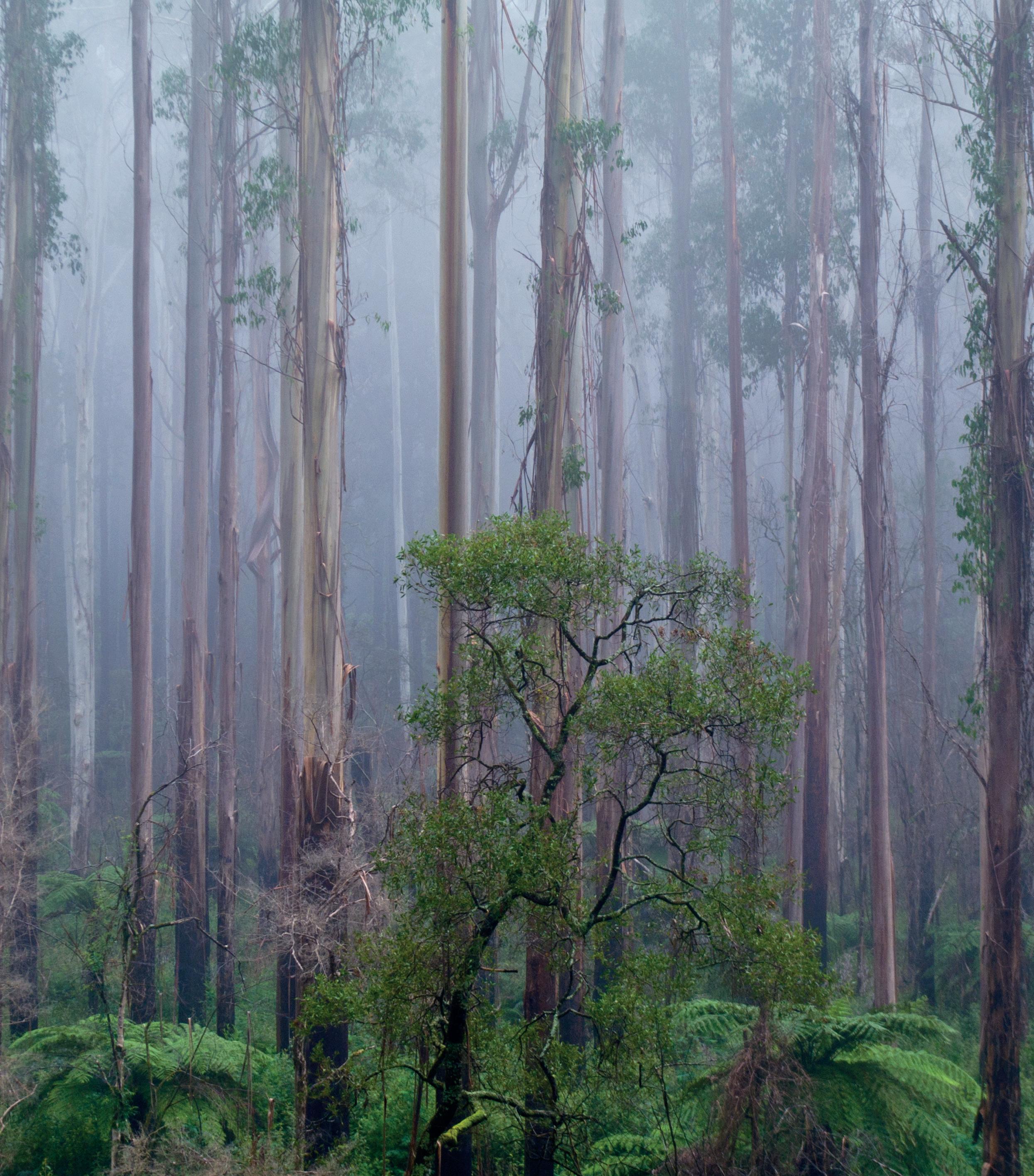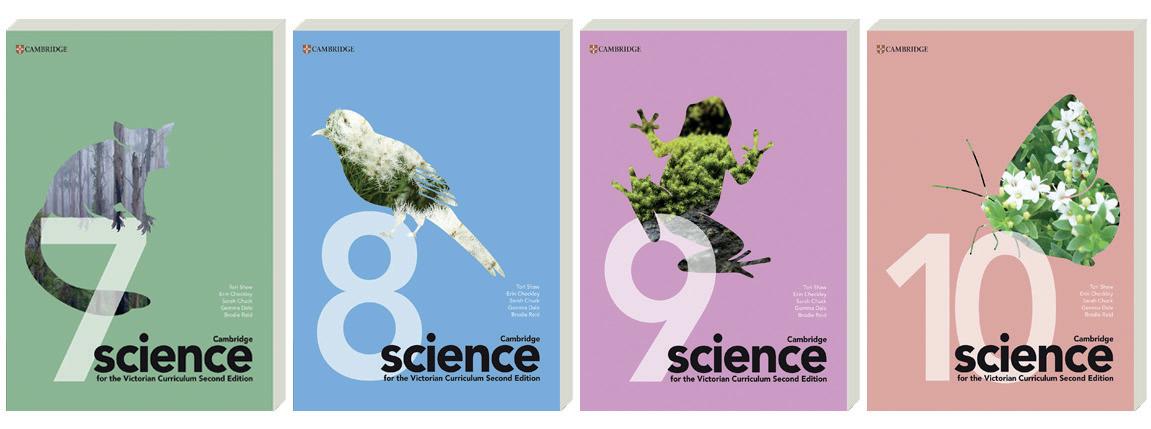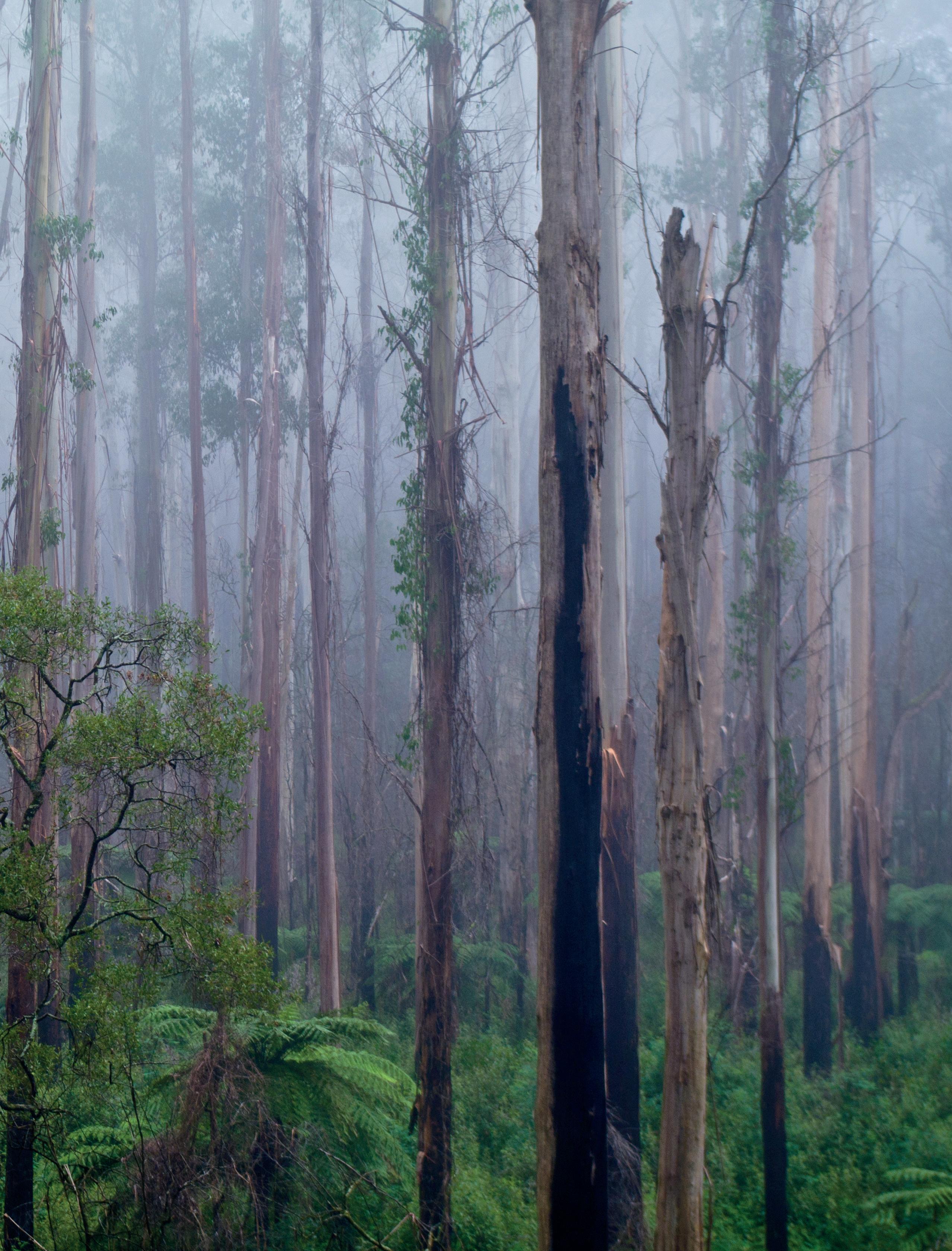
Teaching programs cover each topic of the curriculum to support you with class preparation.
in context and draw connections between topics.
Chapter introductions engage your students with the subject matter, and outline the topic ahead.
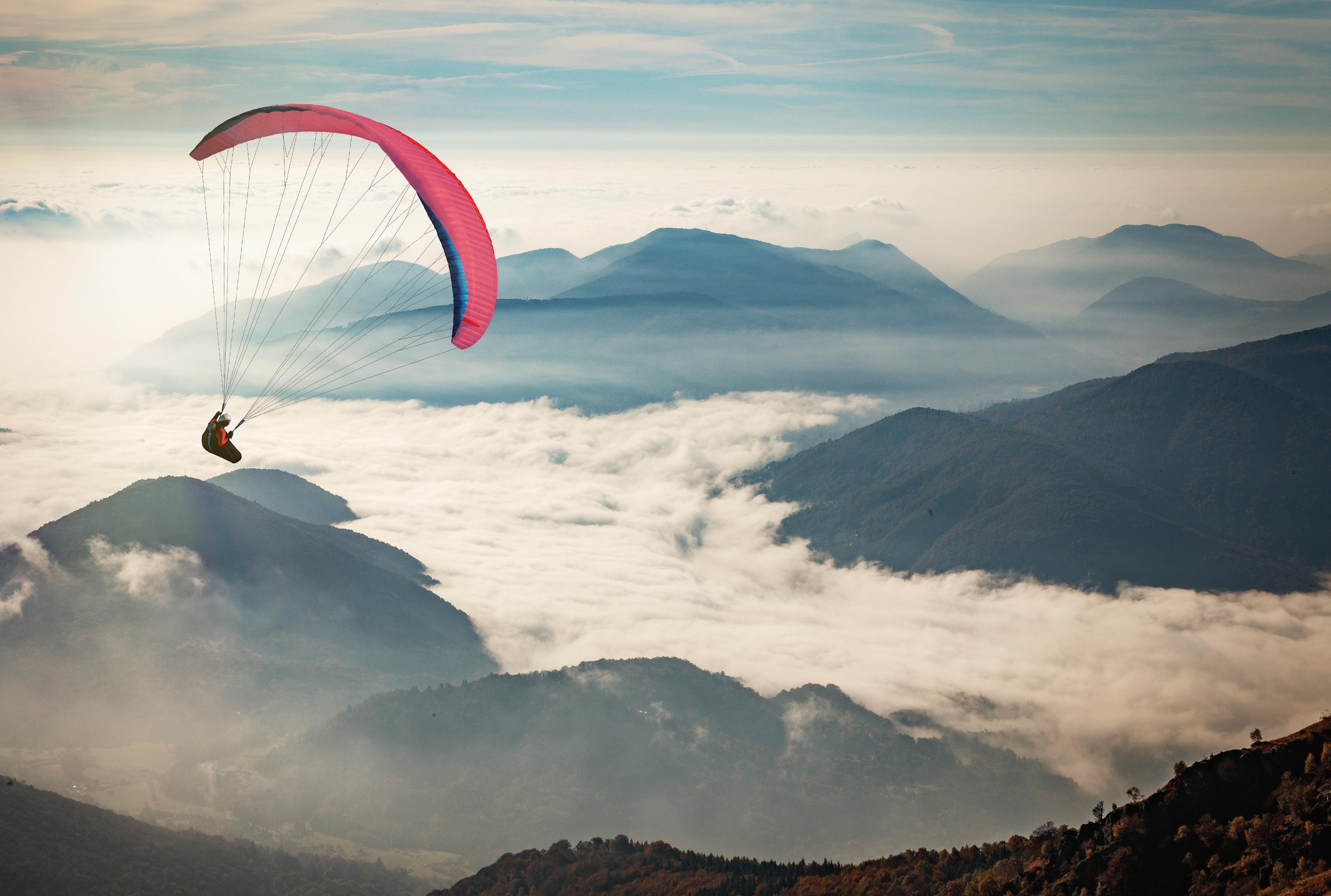


Teaching programs cover each topic of the curriculum to support you with class preparation.
in context and draw connections between topics.
Chapter introductions engage your students with the subject matter, and outline the topic ahead.

Introduction
Whether you are walking, running, sitting in a vehicle, riding a bike or sleeping, forces are acting on you all the time. At school, forces are at work when you pick up a book, write a sentence or open a lunchbox. When you are standing perfectly still, forces act on you to make sure you don't fall through the floor or fly up into the sky. In this chapter, you will explore how to measure and identify forces around you. You will discover how forces can be added together, or cancel each other out. In the final part of the chapter, you will learn about gravity and how Earth's gravity determines the orbit of the Moon.
Learning goals at the start of each section outline what students can expect to learn.

At the end of this section, I will be able to:
1. Recall the term 'force' and describe how forces are measured.
2. Describe the impact of balanced and unbalanced forces on an object.
3. Draw a force arrow diagram to indicate forces acting on an object.
A force acts on an object whenever something is given a push or a pull. Forces are constantly acting on you, and you constantly apply forces to other objects. For example, pressing piano keys, passing a rugby ball, riding the bus and sitting in a chair all involve forces at work. In the human body, muscles apply force when body parts move. In nature, the forces from the flap of a bird's wings allow it to soar in the air, the sweep of a dolphin's tail moves it through the water, and a frog can push on the ground with its legs in order to jump.
The drawing in Figure 8.1 illustrates many forces in action! In pairs, observe and describe specific forces demonstrated in the drawing.
1. One person in the pair identifies an action occurring in the drawing. The other person in the pair then expands on the first person's observation by adding more detail about how a force (a push or a pull) is present.
2 Repeat the game by identifying more actions taking place in the drawing. Take turns observing and elaborating until at least five actions have been observed.
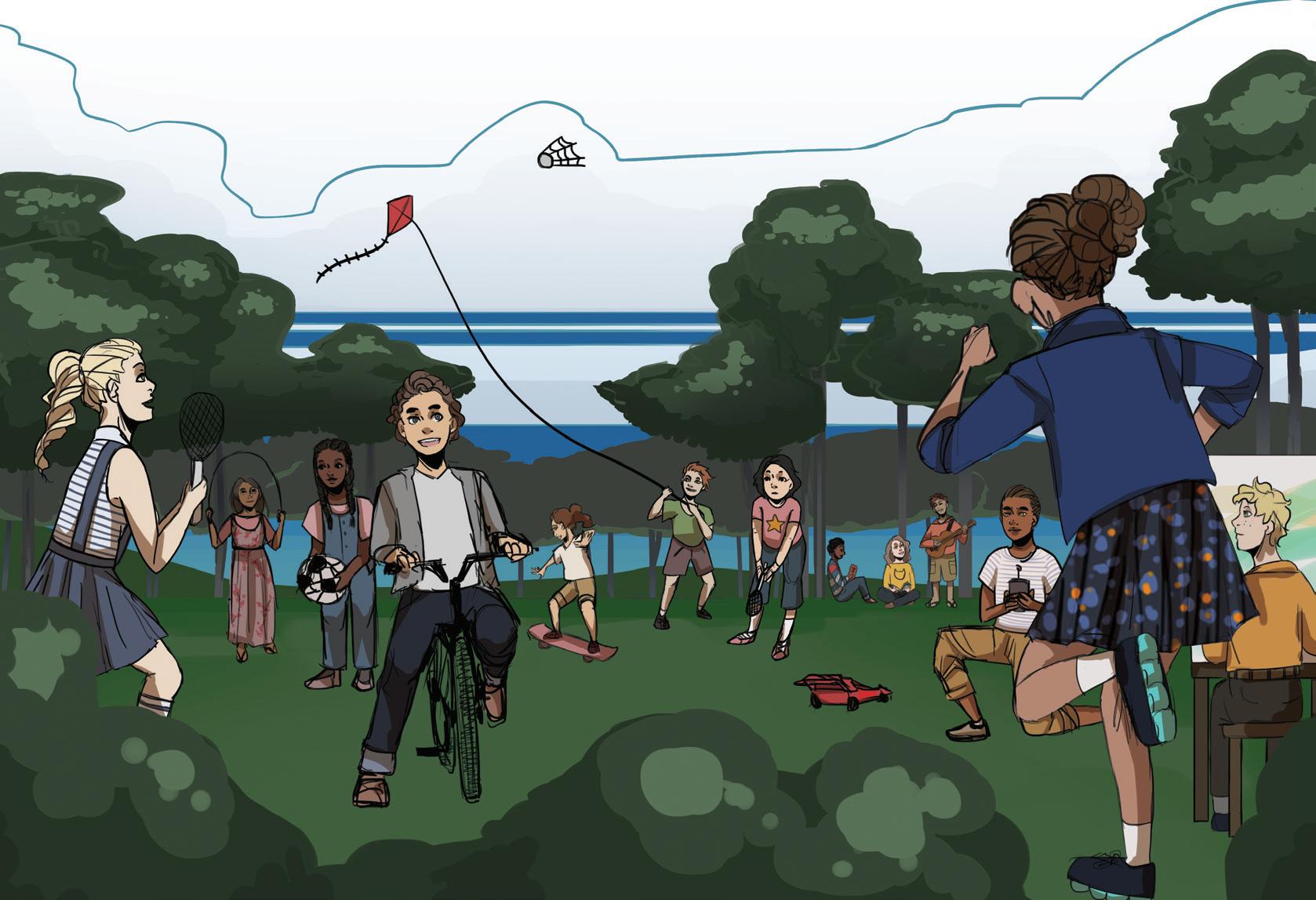
Making thinking visible activities in every chapter encourage your students to discuss and explore contemporary science ideas through Visible Thinking routines, many of which directly address elaborations in the curriculum.
Explore! activities in every chapter encourage students to conduct research online and interpret information, and extend every student.
352 Chapter 8 For C es
Table 8.2 shows how different locations in our universe have different gravitational forces, so a mass of 1 kilogram has different weights in different places.
Surface of a neutron star
Table 8.2 A mass of 1 kg has a different weight at different locations in the universe because of the different strengths of gravity.
The Sun has the strongest gravitational force in the solar system, about 28 times the gravity on Earth. Aside from being too hot, an average person would weigh about the equivalent of two cars on the Sun, and it would require a lot of effort just to move, if the person hadn't already been squished by the weight of their own body! Neutron stars are extremely dense objects that are left behind when some stars explode. They are so dense that 1 cm of human hair on a neutron star would weigh more than the water in an Olympic-size swimming pool on Earth.
Explore! 8.2
Gravity in outer space
Gravity does a lot more than just keep the Moon and planets in orbit. The formation of stars and galaxies is also due to the attractive force of gravity. In fact, when a star is so massive that it collapses into a single point, it forms a black hole. The gravity of a black hole is so strong that nothing can escape – not even light!
Use the NASA Space Place website to research how gravity is involved in the formation of stars, galaxies and black holes.
Try this 8.5
jumping on planets: Mass versus weight
Use a metre ruler and sticky tape to calculate how high you could jump on different planets.
1. Tape the ruler to a table leg or wall so that it is vertical.
2. Get a partner to kneel down so their eyes are level with the ruler.
3. Jump as high as you can while your partner records the height you achieved.
4. Repeat the jump two more times.
5. Swap roles so you are now recording the jump height of your partner. Repeat steps 2–4.
6. Copy the following table into your book and calculate the mean jump height.
Table showing jump heights of students
Student name
Jump height (m) Jump 1 Jump 2 Jump 3 Mean
Long and short Try this hands-on classroom activities provide opportunities to consolidate concepts and make practical connections to the content.
Practical colour-coding makes it easy to locate different types of activities or other pedagogical features.
1. Explain why magnetism is considered a non-contact force.
2. Complete the following sentence: Opposite poles ________ each other, while poles that are the same ________ each other.
3. Explain the difference between a permanent magnet and a temporary magnet.
4. Describe a magnetic field. Draw a picture of the field around a bar magnet and indicate the direction of the magnetic field lines.
nuclear force and the atomic bomb
Another non-contact force occurs within individual particles. The force acting inside particles, holding them together, is called the 'nuclear force'.
During World War II, a Polish scientist, Joseph Rotblat, was working first in England and then in the USA on research to develop the atomic bomb, as part of the Manhattan Project. An atomic bomb would use nuclear forces to release a huge amount of energy. When an atomic bomb was eventually created, it was used by the USA in 1945, on the Japanese cities of Nagasaki and Hiroshima. The devastating outcome continues to be a reminder of the dangers of nuclear weapons.

At the end of 1944, Rotblat withdrew his participation in the research for ethical reasons, as he was well aware that the research he was undertaking would have dire consequences if used in war.
Rotblat was a keen advocate for the peaceful use of scientific research. For his ethical consideration in World War II and his peaceful work after the war, he was awarded the Nobel Peace Prize in 1995.
Earth itself is a giant magnet with magnetic poles near the geographic poles. A suspended magnet will turn until its north pole points geographically north because of its attraction to the south pole of the internal Earth magnet. This is a property of natural magnets or lodestones and has been used by navigators for thousands of years. What is called the north pole by geographers is called the south pole of Earth's magnet by scientists.
Videos in the Interactive Textbook summarise, clarify or extend student knowledge.
How quickly do these animals change appearances?
Here are some things to think about when creating a key.
Characteristics can change over time
Grouping organisms based on their morphology is a common way to classify them; however, this can be problematic. Some physical characteristics, such as hair colour, can vary over an organism's lifetime or even from season to season. Consider your own hair. Is it the same colour now as when you were born? Will it be the same colour when you are 80? You might be classified differently depending on the age you are when someone does the grouping! An example from the animal world is the Arctic fox. In Figure 2.8 you can see the white winter coat that allows the fox to camouflage against the snow and then changes to a grey-brown colour in summer.


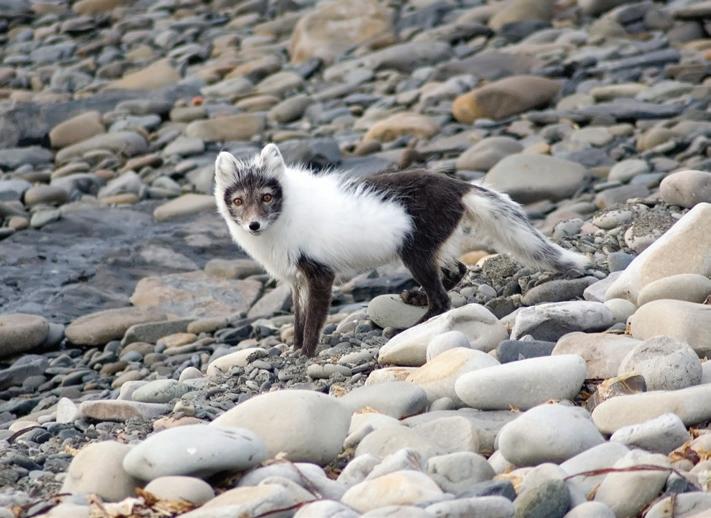
QR codes provide immediate access to selected videos.
Try this 2.2
Making a branching dichotomous key
As a class, discuss some ways to group animals by listing different characteristics. Based on these characteristics, create groups of similar animals, using everyone's favourite animal. Are there different ways you could classify or group the animals? Challenge a classmate to find a certain animal using one of the grouping methods you come up with. Now try to make a branching dichotomous key based on one of the ways you chose to group your animals. Test it on a classmate to see if it works.
The Victorian snake key in Figure 2.7 is focused on a specific characteristic of the snakes at each stage. This is important to remember when constructing a key; otherwise scientists may get different answers when they use the same key. Characteristics can be described in a qualitative way, using words or judgements. Quantitative descriptions measure characteristics using numbers, and are more objective. If you designed a key based on the individuals shown in Figure 2.9, you could qualitatively describe their age as young or old. This would not be a dichotomous classification –what someone else calls young may be different from what you call young! Starting your key with 'Is the individual younger than 20?' would be better as there are only two options to choose from in this case, and the answer is clearer.
Students can learn key terms using glossary definitions next to where the term first appears and at the end of the book.
Year 7 students are encouraged to explore Ways of knowing as they are introduced to the nature of science and examine what IS knowledge in science. See over to learn more.
Learning goals
At the end of this section, I will be able to:
1. Recognise the different ways of making and recording knowledge, including that of Aboriginal and Torres Strait Islander Peoples.
2. List some different fields a scientist might work in.
3. Define the roles of group members in a team of scientists.
Science is not only a collection of knowledge that we have already gathered over time, but also the process of gaining new knowledge and creating shared understanding. Scientists are, and always have been, curious about the world around them. From the first scientists through to scientists working in research institutions today, they are asking and answering questions about the universe, how and why things work, and what happens if you change things.
In many indigenous cultures around the world, oral traditions such as storytelling are the means by which knowledge is passed from one generation to the next. This method has been used for thousands of years, starting long before knowledge was written down, and continues today.
Did you know? 1.1
oral histories
Research published in the Journal of Archaeological Science in 2023 indicates that Palawa (Tasmanian First Nations) stories are some of the oldest recorded oral traditions in the world. They accurately recount geological and astronomical events from around 12 000 years ago (such as seas flooding the land bridge connecting Lutruwita/Tasmania and the mainland) and have been reproduced and passed down through more than 400 successive generations, while maintaining their historical accuracy.
Figure 1.1 Truganini, a Nuennone woman and one of the last speakers of the original Tasmanian languages, survived the initial invasion and colonisation of Lutruwita/Tasmania. The Indigenous population was decimated by introduced diseases, and by genocide committed by the British.
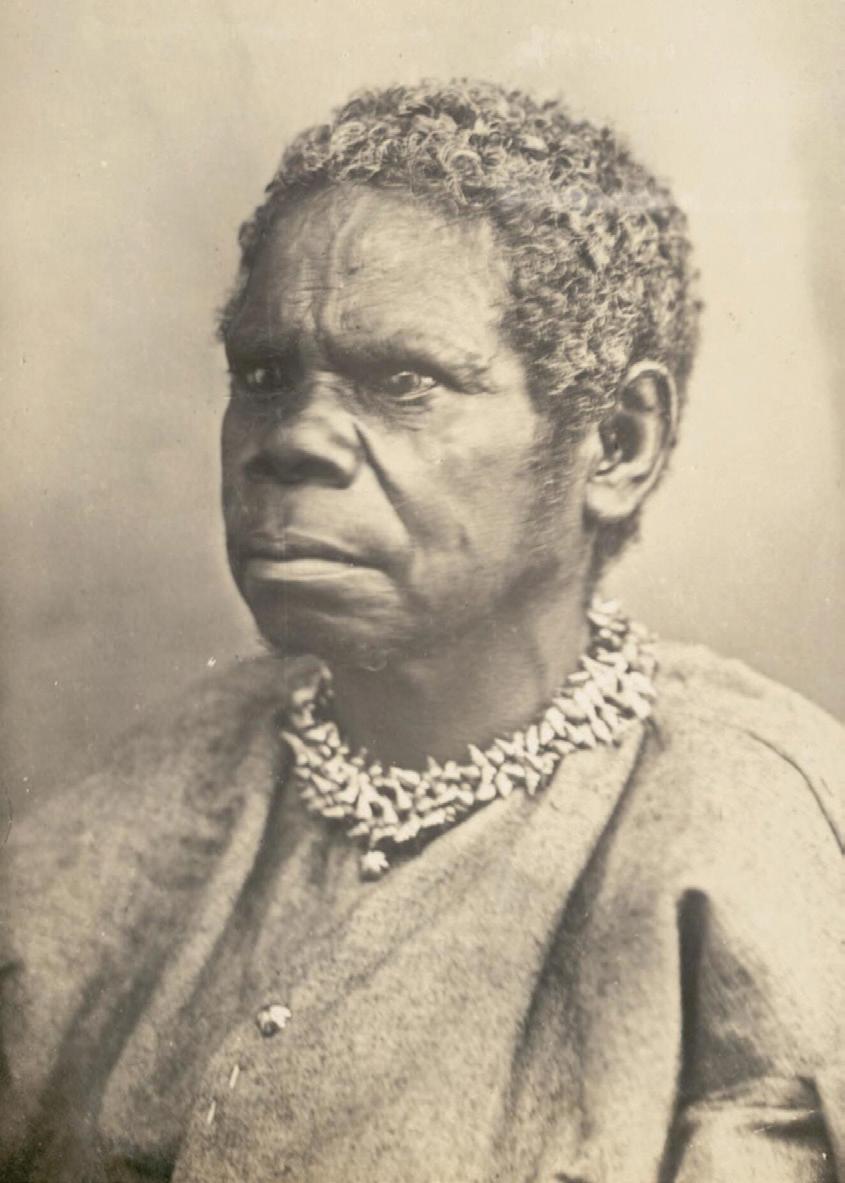
WORKSHEET Knowledge in science
knowledge the understanding of information oral tradition a system for preserving cultural beliefs, knowledge and traditions, passed down verbally or by example from one generation to the next, without written instruction
Sustainability content has been added across all year levels, including Explore! activities in each chapter that consider the sustainability aspect of key concepts.
The wide range of practical activities integrated with the chapter content provide students with plenty of opportunities to establish and apply their skills.
All practical activities are available in the Interactive Textbook as downloadable and editable Word documents.
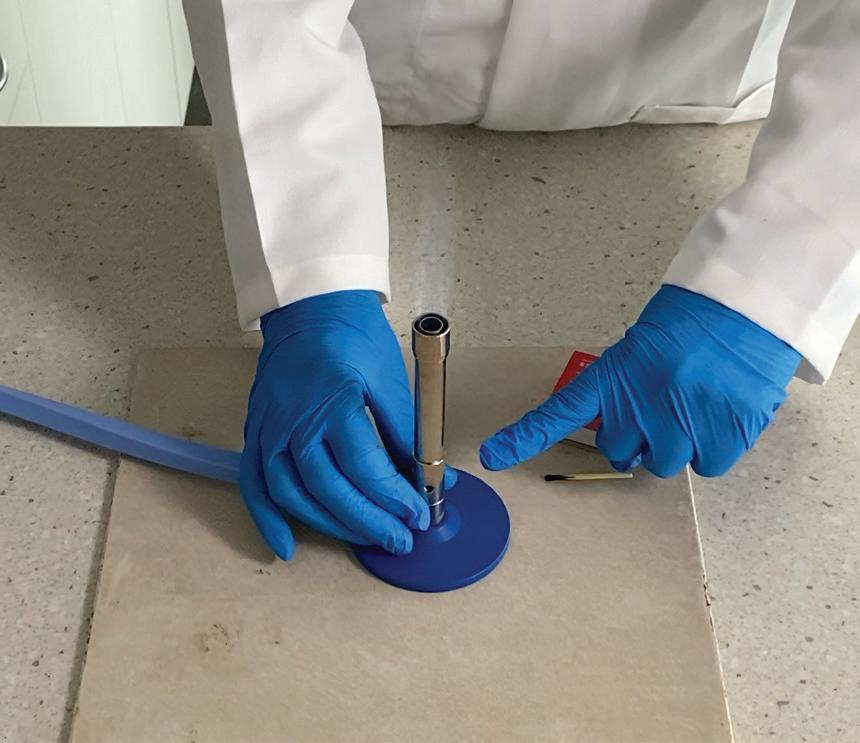

using a bunsen burner
Aim
To practise the safe procedure for lighting a Bunsen burner.
Materials
• Bunsen burner
• heatproof mat
• matches Method
Be careful
Ensure general fire safety measures are observed. Ensure appropriate personal protective equipment is used when handling hot equipment.
1. Check that the rubber tubing is intact, with no damage.
2. Attach the Bunsen burner rubber tubing to a gas tap.
3. Ensure the Bunsen burner hole is closed to give a safety flame.
4. Strike a match away from your body.
5. Turn on the gas.
6. Bring the match up towards the tip of the barrel mouth to light the flame.
7. Shake out the match and place on the heatproof mat.
8. When heating anything, twist the collar to open the airhole and produce a blue flame.
9. When the Bunsen burner is not being used for heating, twist the collar to close the airhole and produce a yellow safety flame.
10. At the end of any Bunsen burner practical, ensure the gas is turned off. Allow the Bunsen burner to cool down before packing it away.
Discussion: Evaluation
1. Explain why the airhole is closed before you turn on the Bunsen burner.
2. Explain why a match is struck away from the body.
3. Explain why the blue flame is used when heating an object.
Practicals are accompanied by comprehensive teacher notes with a range of additional information, including expected results and photos of experimental set ups.
Cognitive
Discussion: Analysis
The data shows a negative relationship (trend) between drop height and bounce height − as drop height decreases, bounce height also decreases. When dropped from 100 cm above the ground, the average bounce height is 65 cm. This reduces to an average bounce height of 20 cm when the ball is dropped from 30 cm.
Discussion: Evaluation
The observer taking the measurements was standing in front of the ruler and visually estimating the height the ball bounced back to. This method could be improved by filming the drop, and pausing the video to more accurately determine the bounce height.
Conclusion
From this experiment, it can be claimed that if drop height increases, then bounce height also increases. This was supported by the observations that when dropped from a height of 50 cm, the tennis ball bounced to an average height of 33 cm, whereas when dropped from a height of 100 cm it bounced back to an average height of 65 cm. Therefore the hypothesis is supported by these findings.
The conclusion is where you answer your research question, justifying it with some key data that you collected. This will allow you to state whether the hypothesis was supported (it is accepted) or not supported (it is rejected).
References are sometimes included after the conclusion. This is where you record sources of information you accessed, such as articles, books or websites (not yourself, your teacher or your group members).
DISCUSSION
The discussion includes an analysis of the data and evaluation of the method. Looking at your data, identify any trends or patterns or relationships. Refer to the data (e.g. the averages) to support any statements you make. Consider your method and any potential errors in your results. Were there any issues with the way you conducted the experiment that could be improved for future investigations? If the data is inconclusive, then perhaps there were more variables that needed to be controlled. The evaluation is not the place to offer your assessment of the activity (e.g. 'I had fun and the experiment was successful.').
Section 1.4 review Go online to access the interactive section review and more!
Section 1.4 questions
Remembering
1. Name the section of a scientific practical report that states whether the hypothesis was supported or not.
2. Name the section of a scientific practical report where you might mention problems you faced and how they could be avoided in the future.
Understanding
3. Explain the meaning of a 'reproducible' method.
Evaluating
4. Justify why you need to be careful when reading scientific information you have found on the internet.
A Success criteria checklist at the end of each chapter, linked to the learning goals, helps students keep track of what they have learned.
Chapter checklist
Success criteria
Linked questions
8.1 I can recall what a force is and how forces are measured. 1, 2, 4
8.1 I can describe the impact of balanced and unbalanced forces on an object. 5, 6, 7, 10, 11, 12
8.1 I can draw a force arrow diagram to indicate the forces acting on an object. 9
8.2 I can describe some contact forces. 3, 14, 15, 16
8.3 I can describe the effect of Earth's gravitational force. 8
8.3 I can describe three non-contact forces. 3, 13
Review questions
Remembering
1. Define the term 'force'.
2. State the units for mass and weight.
3. List three contact forces and three non-contact forces.
4. Define the term 'net force'.
5. Recall the word that is used to describe two forces that are equal in size and act in opposite directions.
6. State whether an object can change direction without a force.
7. State whether an object always moves when a force acts on it.
8. Describe, using your knowledge of forces, why the Moon orbits Earth and why Earth orbits the Sun.
9. Draw or describe the pair of equal and opposite forces on each of the koalas in Figure 8.54.

Students can compete against the clock, their classmates or other Victorian students using Scorcher, our timed, online competition quizzes at the end of each chapter.
Victorian examples of scientific principles in action are used wherever possible to help your students make connections in their science learning.
Understanding
10. Describe what happens if the forces on an object are unbalanced.
11. Explain whether an object that is travelling horizontally in a straight line at a constant speed needs a force to keep moving.
Applying
12. There are many forces between the parts of the Bolte Bridge in Melbourne (see Figure 8.55). Explain whether all the forces between the parts are balanced or unbalanced.

13. Metal recycling takes place in most cities. Aluminium, copper and steel are the most common metals that are recycled. After collection, the first step is to flatten the metal and then cut it into small pieces. The second step is to separate the iron and steel from the aluminium and copper before finally melting the metals ready to be used again. Describe a way that could be used to easily carry out the second step.
14. Figure 8.56 shows a scientist inspecting seagrass. Around his waist he is wearing a heavy belt. Using your knowledge of forces, propose the function of this belt.
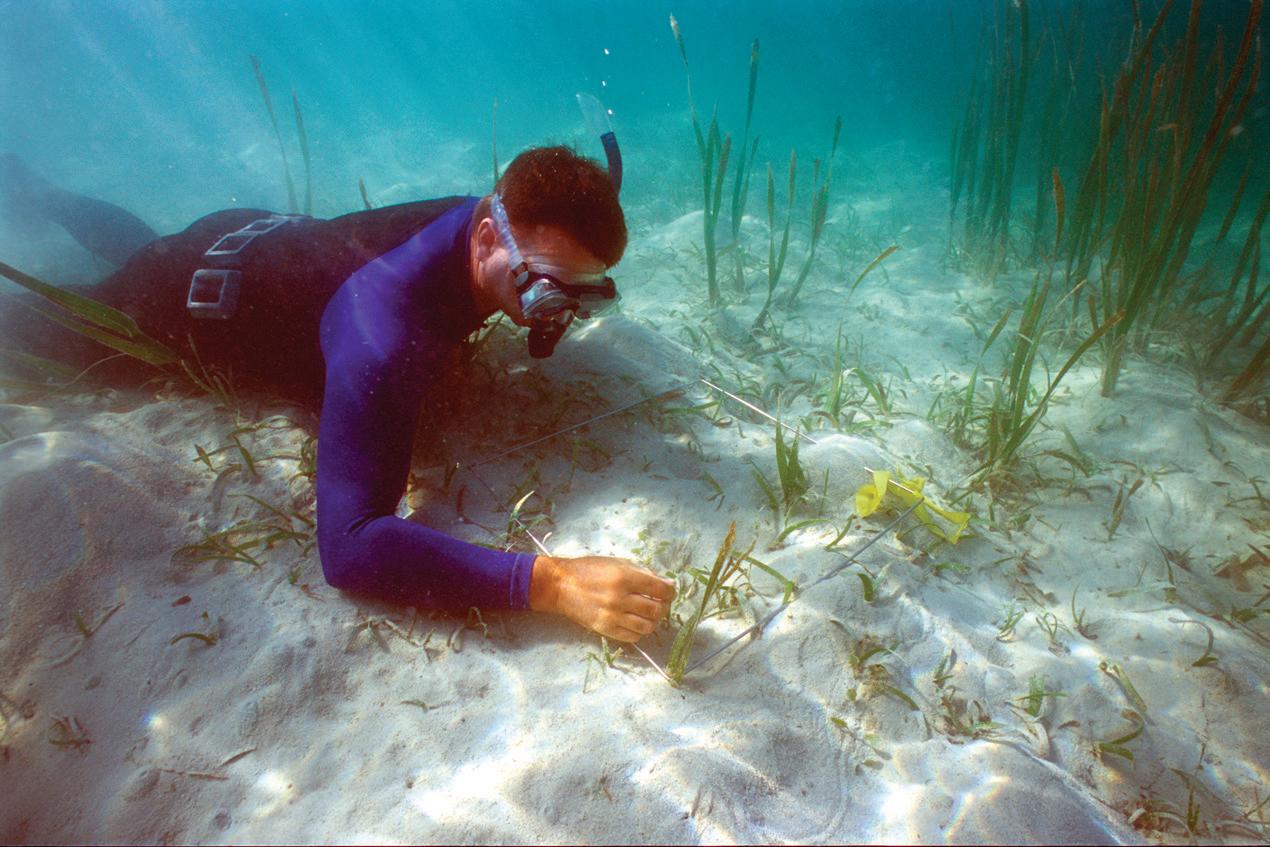
Review questions are categorised under the headings: Remembering, Understanding, Applying, Analysing, and Evaluating
Review questions are categorised under the headings: Remembering, Understanding, Applying, Analysing, and Evaluating.
Analysing
15. On snow and ice, wheels with tyres are often replaced by skis and tracks on vehicles. Consider the skis and the tyres in Figure 8.57 and how their shape and friction forces relate to their use.
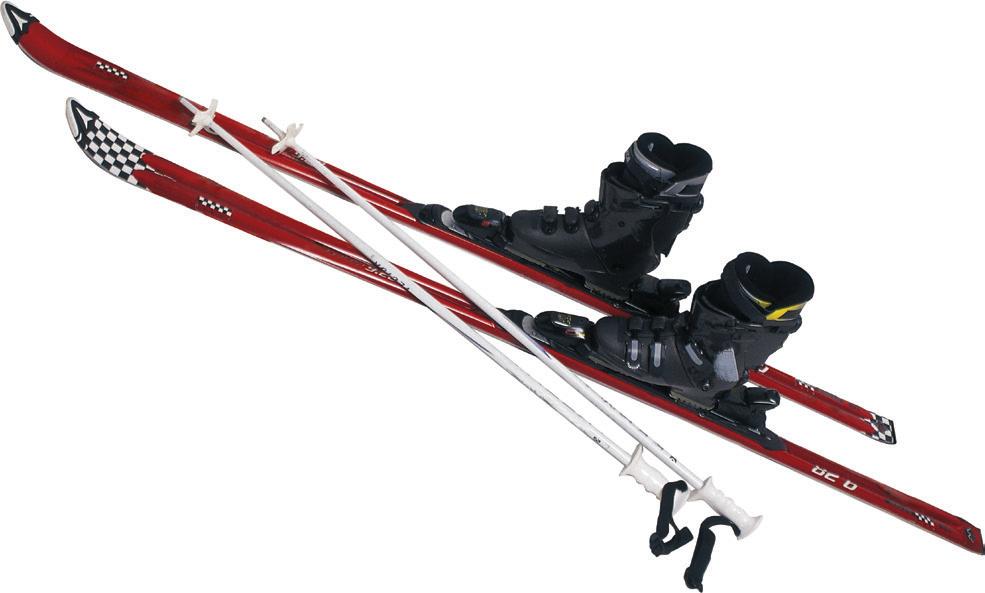

Evaluating
16. Use your answer to the previous question and your knowledge of forces to justify using a snowmobile in the snow rather than a normal motorcycle.
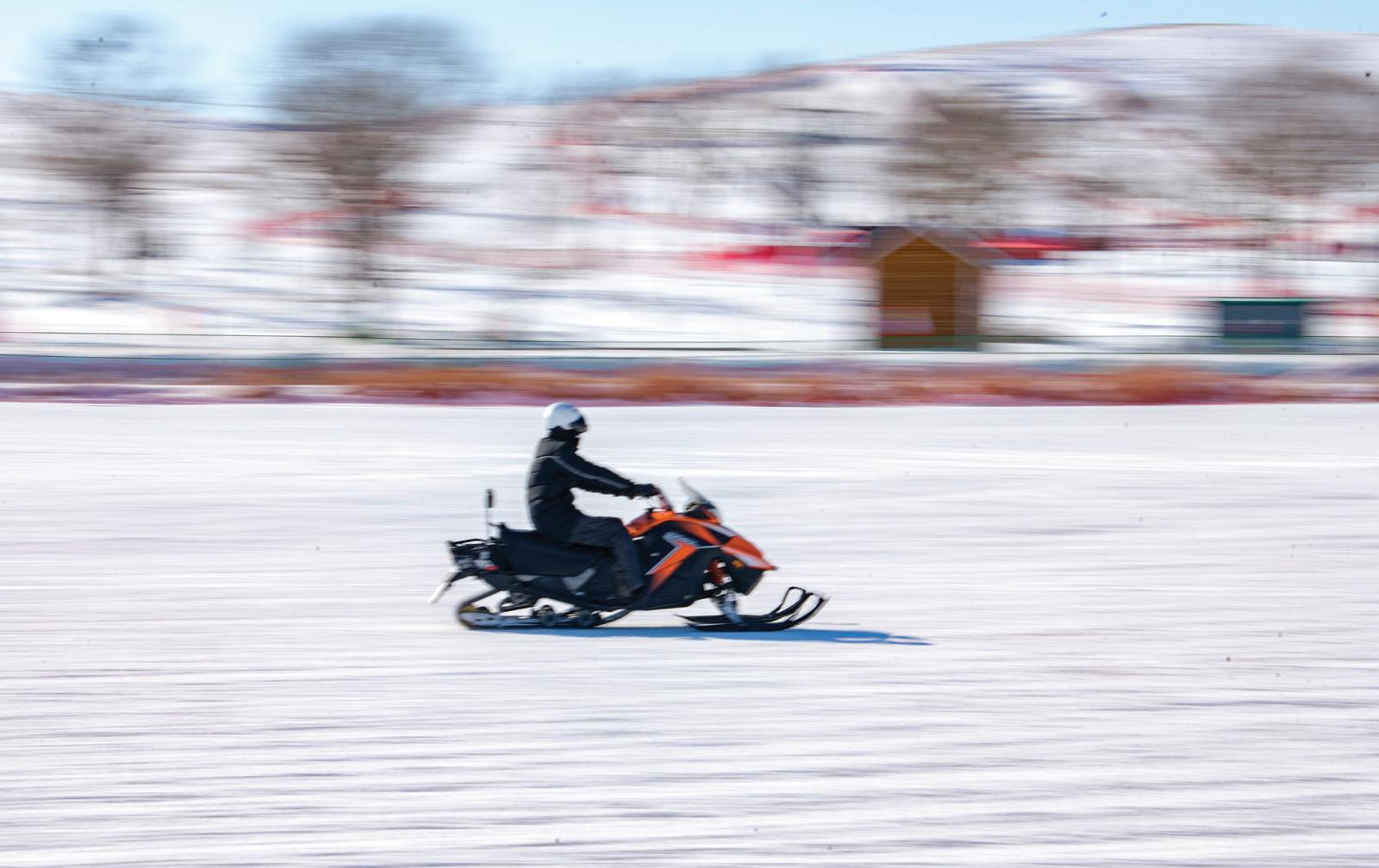
Data questions
Earth's Moon and the other planets in our solar system have different forces of gravity on their surface than Earth does, because they have different masses. These forces of gravity on the surface of each are shown with respect to that of Earth in Figure 8.59.
Figure 8.59 Gravity on the Moon and other planets relative to that of Earth, given their relative masses
Applying
1. Identify which planet (not the Moon) in the graph has the lowest mass.
2. Determine which planet has a force of gravity closest to that on Earth.
3. If the acceleration of Earth's gravity is 9.8 m/s2, and the gravity on Mars is 38 per cent of that of Earth, calculate the force of gravity on Mars.
Analysing
4. Identify the general relationship between the mass of a planet and the force of gravity.
5. Use the data in the graph to contrast the gravitational forces of Earth and Mercury.
6. Deduce why the Moon orbits Earth, instead of Earth orbiting the Moon.
Evaluating
7. The mass of Jupiter is approximately 318 times that of Earth. Predict whether the force of gravity on Jupiter would be greater or less than that on Earth.
8. On two of the planets in the graph, a person standing on their surface would weigh about the same. Infer which two planets they are.
9. Pluto has a relative force of gravity of 0.07 of Earth's. Use the relationship you identified in Question 4 to justify the statement that Pluto's mass is less than that of Earth's Moon.
Data questions at the end of each chapter help students apply their understanding and challenge them to analyse and interpret different forms of data linked to the chapter content.
Each activity can be completed using readily available materials in one or two lessons.
Suggested materials
• ruler and tape measure
• scissors
• cardboard
• bubble wrap
• plastic bags
• 100 g parcels of sugar/salt × 5 (payload)
• sticky tape (duct tape or gaffer tape would be good)
Research and feasibility
1. List the features that would make a useful boat.
2. Research the terms 'density' and 'buoyancy' and discuss in your group how these factors are important in boat design.
Design
3. List all the materials that you have available and that you plan to use for your ferry.
4. Design a ferry that is capable of transporting your payload (set mass) between two points and return.
5. Label and include measurements of your ferry.
Create
6. Build your ferry using the materials, checking as you progress that your ferry is capable of floating.
Evaluate and modify
7. Discuss the challenges you have encountered throughout this project with at least three of your peers. List the strategies or actions that allowed you to overcome it.
8. Create a list of improvements to your design that could be applied to this project to refine its performance.

